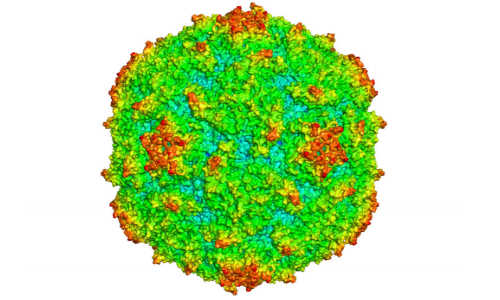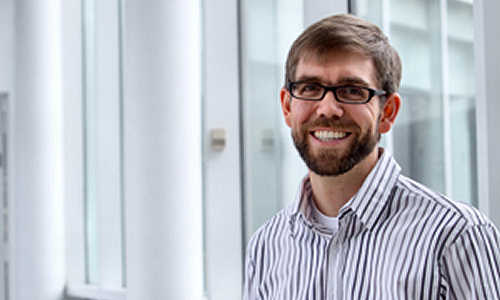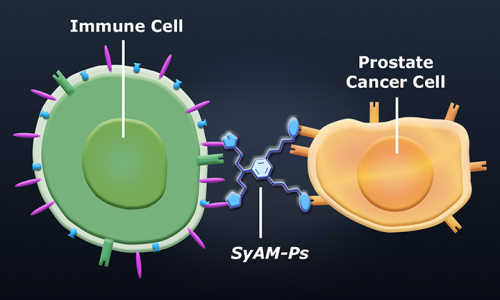Scientists from the UK and USA are using technology that helped in the design of a new synthetic vaccine to combat the foot and mouth disease virus (FMDV) to now target the virus that causes polio. The synthetic vaccine that is currently being engineered in collaboration with Prof. Dave Rowlands at the University of Leeds would provide a powerful weapon in the fight to rid the world of polio. This project is being funded by a £438,000 grant from the World Health Organisation and the Bill & Melinda Gates Foundation.
This is a radius colored surface representation of Type 1 poliovirus (Mahoney). The surface is colored from blue to red according to the distance from the particle center. Photo Credit: Dr. Liz Fry, Dept. Structural Biology, Oxford University
The team’s hope is to create a vaccine that does not contain the viral genome but instead ‘mimics’ the structure of the live virus. Such a vaccine would be quicker, easier and safer to produce. Even after the apparent global elimination of poliomyelitis it will be necessary to continue vaccination as a precaution against reintroduction of the virus from hidden sources, such as rare chronically infected carriers. A synthetic vaccine would fulfil this role without the inherent danger of accidental release of virus associated with the production of current vaccines. Eventually such vaccines could pave the way to completely eliminating the necessity to vaccinate
Speaking at the American Association for the Advancement of Science (AAAS 2015) meeting in San Jose on the 13th February 2015, Prof Dave Stuart, Life Sciences Director at Diamond Light Source, the UK’s national synchrotron science facility, and Professor of Structural Biology at Oxford University, explains: “Using a combination of techniques, including X-ray crystallography at Diamond and electron cryo-microscopy in Oxford, we’ve begun the task of gathering crystal structures and electron microscopy images that will tell us what we need to know to stabilise the shell of the virus and engineer a strong vaccine that has the ability to bring about the desired immune response in humans.”
“Following on from the success we’ve had with the foot and mouth disease vaccine, we aim to transfer the approach to vaccines for other viruses including polio. Early results with polio are very promising, with synthetic particles being produced and evidence of successful stabilisation.”
Prof Stuart has devoted his career as a structural biologist to outsmarting viruses to benefit human and animal health. 21st Century technology will, he believes, play a key role in helping us to dramatically improve our response times when new virus outbreaks occur. He adds, “Our basic research capabilities are being greatly enhanced by developments in a number of key areas such as synchrotron light sources, light microscopy and the now fantastically powerful electron microscopy technique.”
“Using the latest technology, we can engineer vaccines that are billions of times smaller than a pinhead, we can track viruses as they interact with living cells, and we can glean the detailed information required to look at pathogens and then design better therapies against them. At the same time, out in the field, we can have DNA sequencers that can aid gene sequencing and help speed up the process of designing new synthetic vaccines with the added advantage of not having to send deadly virus samples around the world.”
Scientists working on the next generation of vaccines and inhibitors to combat viruses and bacterial infections will have their research capabilities greatly enhanced when the UK’s new Electron Bio-Imaging Centre (eBIC) opens in late 2015. Conveniently located next to Diamond’s synchrotron building, the centre’s powerful cryo-electron microscopes will allow scientists to visualise the structure of the cell to help further understand molecular make-up and will provide new tools to image single bio-molecules.
Story Source:
The above story is based on materials provided by Oxford University.





